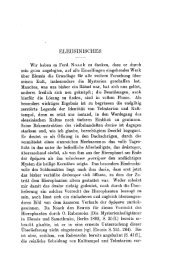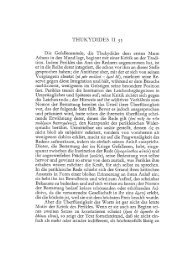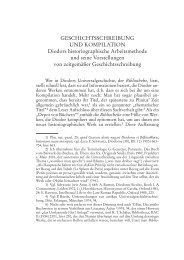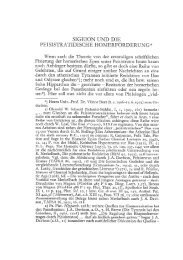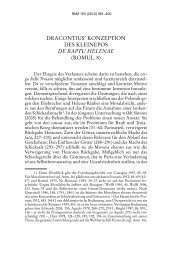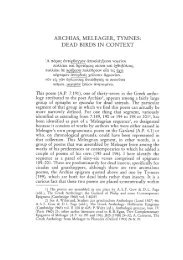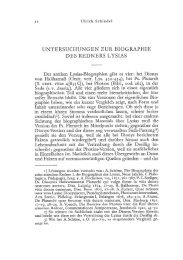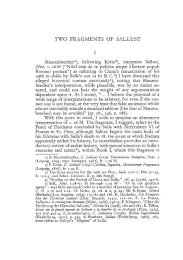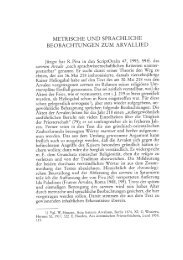THE GEOGRAPHY OF THE PROMETHEUS VINCTUSI
THE GEOGRAPHY OF THE PROMETHEUS VINCTUSI
THE GEOGRAPHY OF THE PROMETHEUS VINCTUSI
You also want an ePaper? Increase the reach of your titles
YUMPU automatically turns print PDFs into web optimized ePapers that Google loves.
132 Margalit Finkelberg<br />
east, we can suggest this as the reason why Prometheus was transferred<br />
from his usuallocation in the east to the far north-west of<br />
the world 39 •<br />
At the same time, these horizons were short-lived. The picture<br />
of the world as found in the P.V. was soon superseded by a<br />
new bulk of geographical information which began to be accumulated<br />
from the end of the fourth century. In the east, Alexander's<br />
expeditions proved some of the earlier suppositions unwarranted,<br />
notably that of aland-bridge between India and Libya; in the west,<br />
increasing contacts with Rome led to a much more accurate knowledge<br />
of the European continent to the north of the Mediterranean<br />
40 • This is why both Ctesias and especially Pytheas ceased to<br />
be regarded as serious geographers in later generations. It should<br />
not be forgotten, however, that Pytheas' was the geography with<br />
which Timaeus worked, and that Aristotle leaned heavily on the<br />
information found in Ctesias. We can see now that the same can be<br />
said of the author of the geographical sketch of the P.V.<br />
III<br />
As far as I can see, it is unlikely that the above arguments in<br />
favour of a fourth-century date for Prometheus' instructions to 10<br />
have any bearing on the much-vexed question of the authenticity<br />
of the P.V. Even when the Prometheus Vinctus is not recognized as<br />
belonging to Aeschylus, scholars unequivocally place it in the fifth<br />
39) Ir seems that Prometheus' position was generally regarded as symbolic<br />
of the end of the earth, cf. his removal to the Indian Caucasus after the latter had<br />
become known to the Greeks (see n. 5 above). As far as the Prometheus of the P.V.<br />
is concerned, it is possible that the steep rock above the northern ocean to which he<br />
is chained can be traced to "some northern colurnn at the end of the world" ("w;<br />
lloxul:T) 0l:11A.T) ßaQELOt;) described in Ps.-Scymn. 188-95; cf. its further description<br />
at 11. 189-90: EOl:L Ö' u'VT)A.T] ltUVU ett; KU!lUl:WÖEt; ltEA.UYOt; aVatELVoUO' iiKQUV.<br />
(According to Thomson 89, this is a borrowing from the account of Europe given<br />
by the fourth-century historian Ephorus.) This column seems to have marked the<br />
northern boundary of the earth, see further C. Müller's commentary ad locum in<br />
Geographi Graeci minores i 211-212. Ir is not out of the question that Herculis<br />
columnae whose existence at approximately the same place is reported by Tacitus in<br />
Germany 34 mayaiso be relevant in this connection.<br />
40) Cf. Strabo 1.2.1 p. 14C.: "For Alexander opened up for us geographers a<br />
great part of Asia and all the northern part of Europe as far as the Ister River; the<br />
Romans have made known all the western part of Europe as far as the river Albis<br />
[Eibe] (which divides Germany into two parts), and the regions beyond the Ister as<br />
far as the Tyras [Dniester] River ..." Cf. also Polyb. 3.59.



